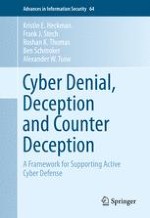2015 | OriginalPaper | Buchkapitel
2. Bridging the Classical D&D and Cyber Security Domains
verfasst von : Kristin E. Heckman, Frank J. Stech, Roshan K. Thomas, Ben Schmoker, Alexander W. Tsow
Erschienen in: Cyber Denial, Deception and Counter Deception
Aktivieren Sie unsere intelligente Suche, um passende Fachinhalte oder Patente zu finden.
Wählen Sie Textabschnitte aus um mit Künstlicher Intelligenz passenden Patente zu finden. powered by
Markieren Sie Textabschnitte, um KI-gestützt weitere passende Inhalte zu finden. powered by
